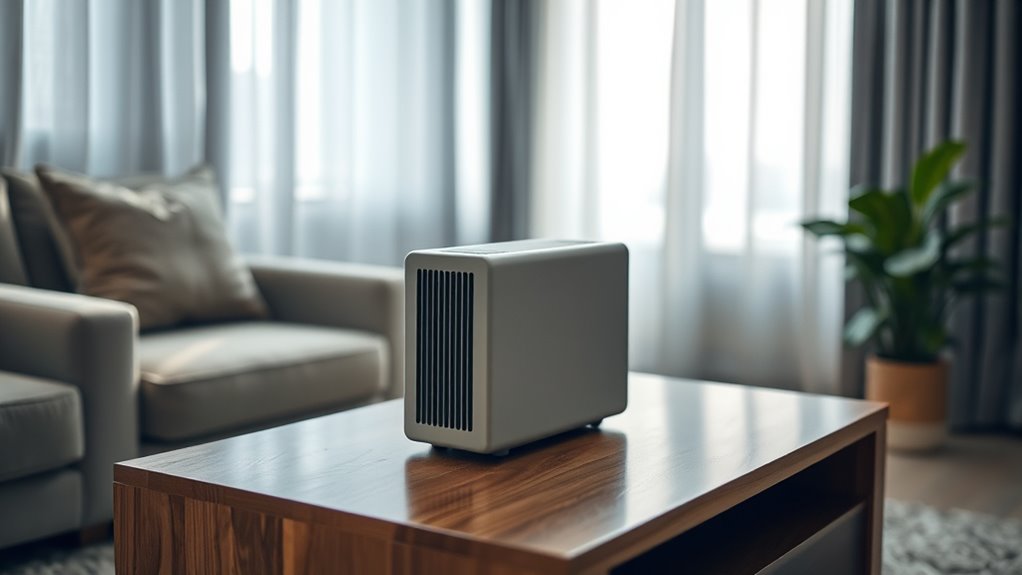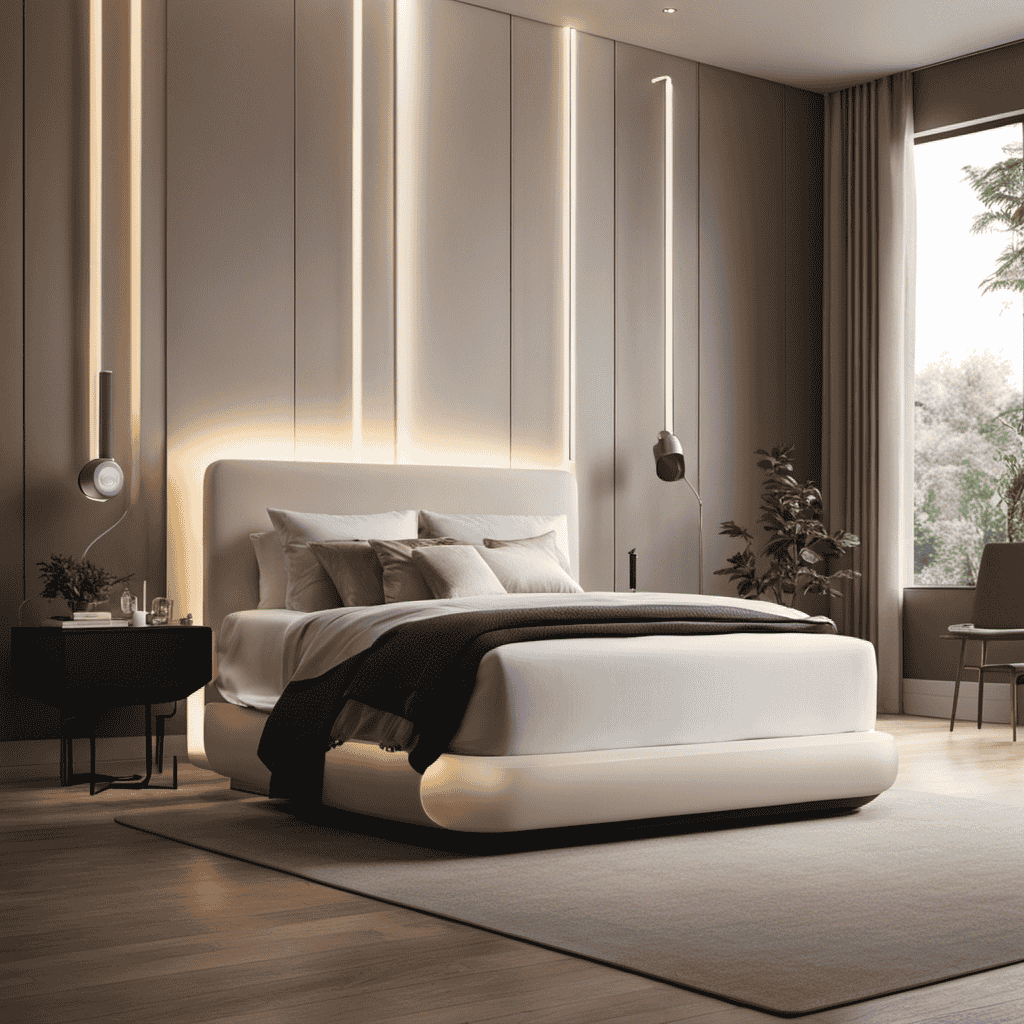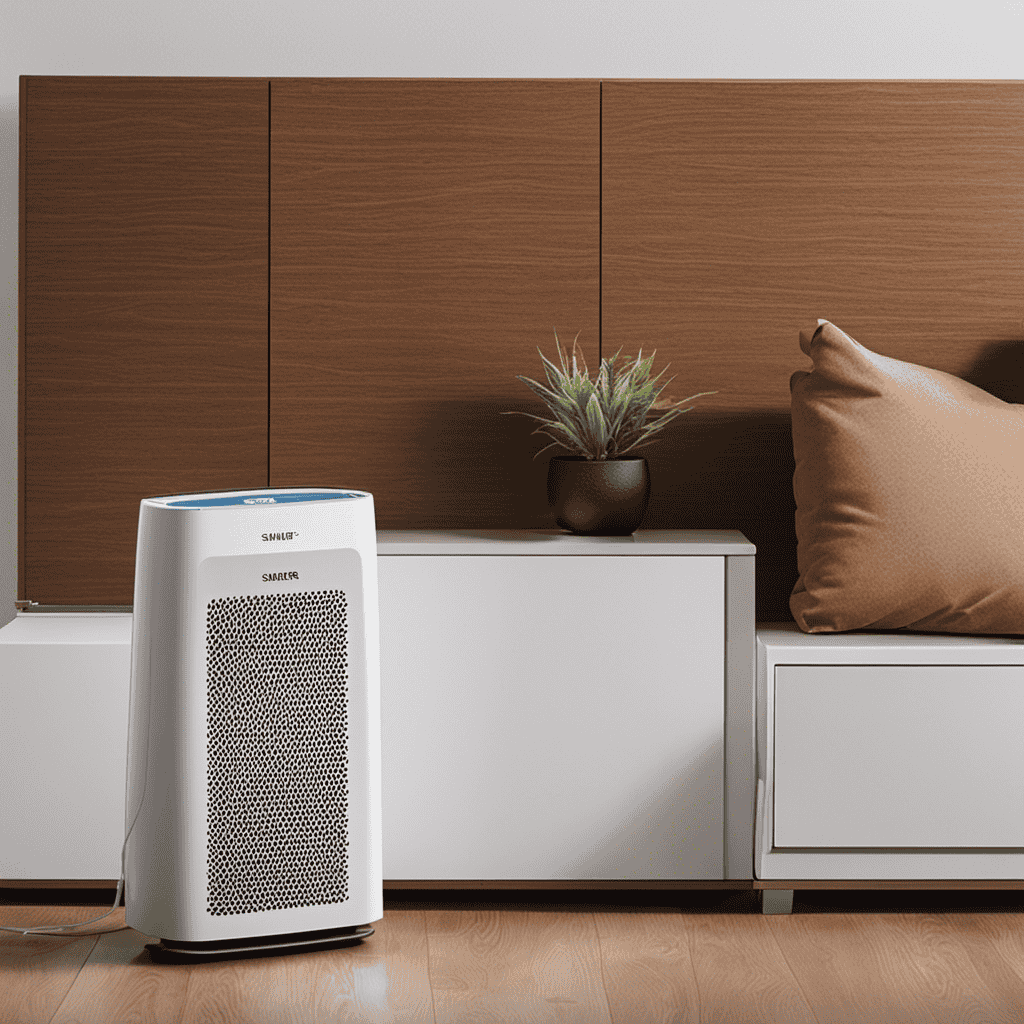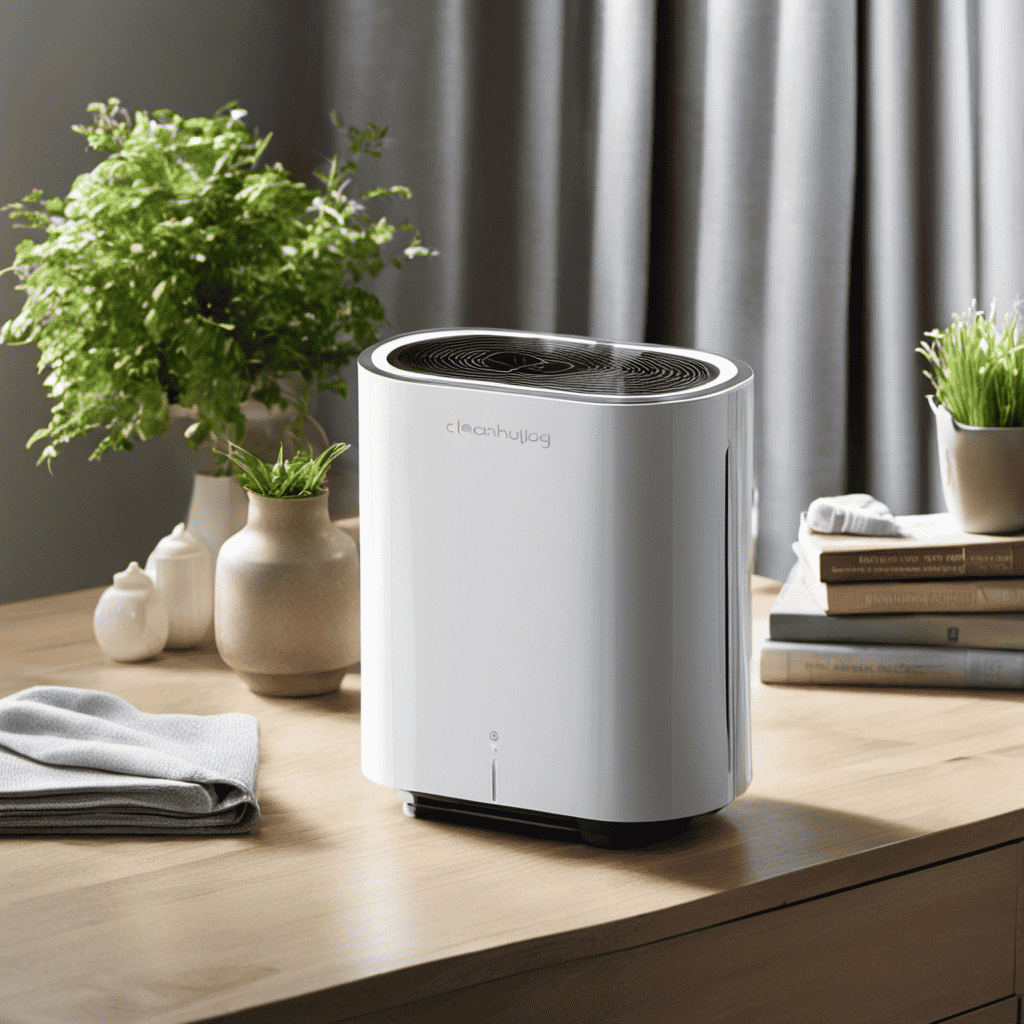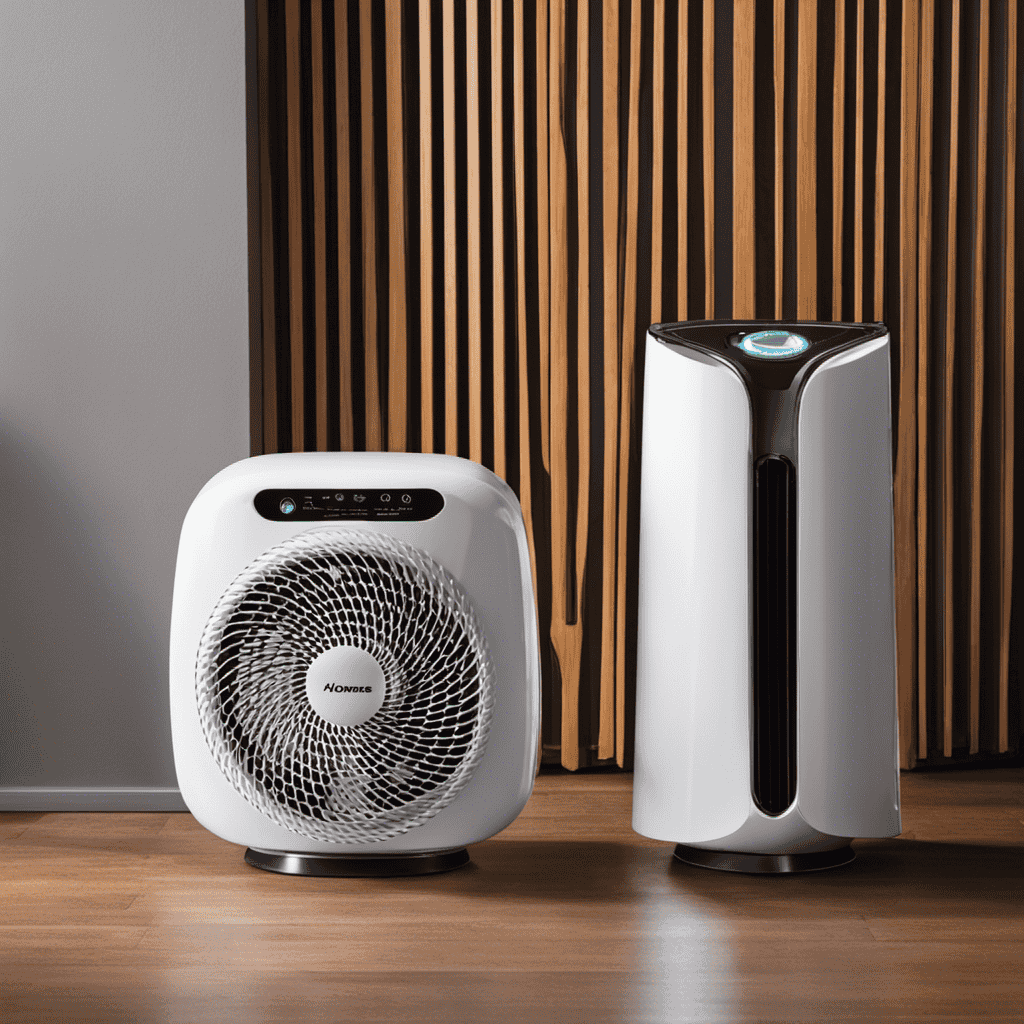To reduce air purifier noise, choose a model with noise-reduction features and operate it on the lowest fan speed, especially at night. Place it centrally on a stable surface, away from walls and furniture, and use sound-absorbing materials nearby. Regularly clean filters and vents to prevent excess noise from dust buildup. Fix any vibrations or loose parts to keep operations smooth. If you want more tips, you’ll find useful strategies to silence your purifier further.
Key Takeaways
- Select air purifiers with noise-insulating features and operate on the lowest fan speed setting for quieter airflow.
- Position the unit centrally and elevate it to reduce vibrations and prevent airflow obstructions.
- Use sound-absorbing materials like acoustic panels and hang soundproof curtains around the purifier.
- Ensure airflow pathways are clear, avoiding placement against walls or behind furniture to minimize turbulence.
- Regularly clean filters, vents, and fan components to prevent noise caused by dust buildup and mechanical issues.
Choose a Quieter Air Purifier Model
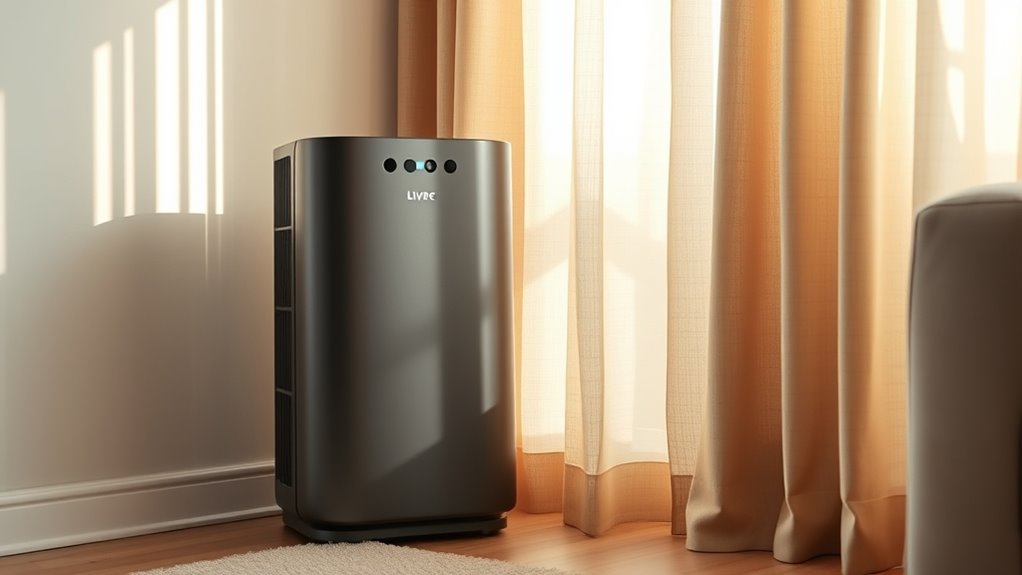
To effectively reduce air purifier noise, start by choosing a model specifically designed to operate quietly. Look for units with built-in noise insulation features that minimize sound output during operation. A quieter model often has a low decibel rating, ensuring it won’t disturb your daily activities or sleep. Additionally, consider appliances with easy filter replacement options; a well-designed filter system maintains ideal airflow and reduces unnecessary noise caused by strain on the motor. Selecting a model with advanced noise reduction technology can make a significant difference. Using noise-reducing features can further enhance your experience by decreasing operational sounds. Incorporating soundproofing materials into your setup can help absorb residual noise and improve overall quietness. Choosing models with HEPA filtration ensures effective allergen removal while maintaining quieter operation, especially when filters are clean. Proper airflow management within the device can prevent turbulent air and reduce noise levels. Investing in a high-quality, noise-insulated air purifier can also prevent vibrations that contribute to sound, making your environment more peaceful.
Place Your Air Purifier Strategically
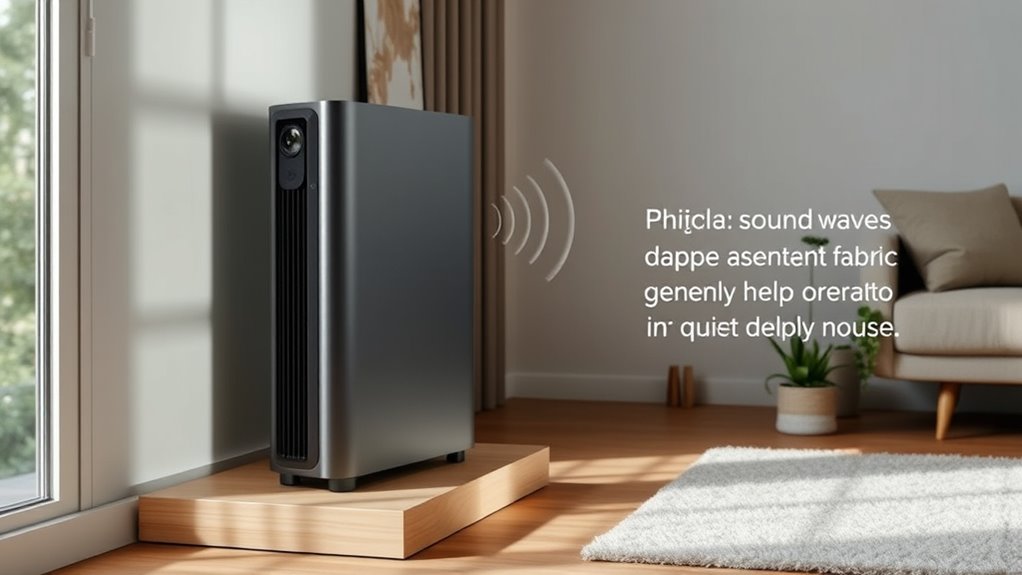
To minimize noise, think carefully about where you place your air purifier. Keep it in an open, central spot for better airflow and quieter operation. Also, avoid placing it against walls or behind furniture, and elevate it on a stable surface for ideal sound levels. Utilizing soundproof mats can additionally help dampen vibrations and reduce noise further. Being mindful of city dynamics and neighborhood layout can also influence how effectively your purifier operates quietly in your space. Selecting a model with low noise levels can further enhance your experience and ensure a peaceful environment. Additionally, choosing a purifier with auto function settings allows it to operate more efficiently and quietly based on real-time air quality detection.
Optimal Room Placement
Placing your air purifier in the right spot can substantially reduce noise levels while maximizing its effectiveness. To do this, consider your room size and how air circulation works. For larger rooms, position the purifier closer to the center to promote even airflow and noise distribution. In smaller spaces, avoid placing it right next to walls or corners, as this can create echoing or amplify noise. Keep it elevated on a table or shelf for quieter operation and better air intake. Make sure it’s not directly against furniture or curtains, which can obstruct airflow and increase noise. Additionally, understanding air circulation dynamics can help you choose the optimal placement for both noise reduction and purification efficiency. Proper placement also minimizes airflow obstruction, ensuring the purifier operates smoothly and quietly. Being mindful of airflow patterns can further enhance the effectiveness of your air purifier while keeping noise to a minimum. By strategically choosing the placement, you improve air circulation and ensure quieter, more efficient operation. Remember, the goal is to balance sound reduction with effective purification, creating a healthier indoor environment.
Avoid Obstructions
Ensuring your air purifier isn’t blocked by furniture or curtains can considerably reduce operational noise. Obstructions create airflow restrictions, forcing the unit to work harder and increasing noise levels. To optimize quiet operation, place your purifier in an open, unobstructed area with ample space around it. Be mindful of user awareness—regularly check that nothing is blocking vents or air intake areas, especially as furniture shifts or curtains move. Clear airflow pathways help the purifier operate smoothly and quietly. Avoid placing it directly against walls or behind objects that can impede airflow. Proper placement also involves considering air purifier maintenance and cleaning, as dust buildup and debris can further hinder performance and noise levels. Additionally, choosing a model with a quiet operation feature can significantly decrease noise during use. By strategically positioning your unit where airflow restrictions are minimized, you’ll enjoy quieter operation and better air circulation, making your space more comfortable and healthier.
Elevate the Unit
Elevating your air purifier can substantially reduce noise by improving airflow and minimizing vibrations. Place it on a sturdy, elevated surface like a shelf or table to help prevent rattling and direct sound away from ear level. This positioning also allows air quality sensors to work more effectively, as they won’t be obstructed by furniture or clutter. When you elevate the unit, ensure it’s in a central location for better air circulation. Additionally, a higher placement makes it easier to notice when it’s time for filter replacement, keeping your device operating quietly and efficiently. Regular filter changes help maintain peak airflow and noise levels, ensuring your purifier runs smoothly without unnecessary noise caused by clogged filters. Incorporating proper placement techniques can further enhance both performance and quiet operation. Proper placement also helps prevent vibration transfer, which can contribute to noise. To further optimize your air purifier’s operation, consider ensuring that the surface it rests on is firm and level, which can help reduce unwanted vibrations and noise. Leveraging AI-powered features in some modern purifiers can also optimize operation and reduce unnecessary noise during quieter periods.
Use the Lowest Fan Speed Setting
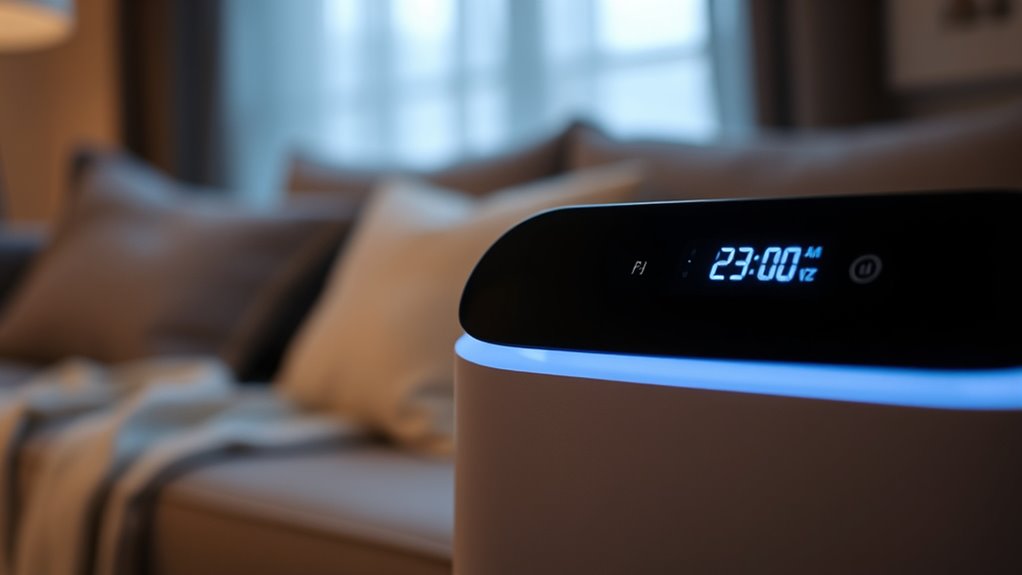
Switch your air purifier to the lowest fan speed to minimize noise. This gentle mode balances quiet operation with effective airflow, making it less disruptive. By doing so, you can enjoy cleaner air without the constant hum. Additionally, choosing the appropriate mode can help you maintain a peaceful environment during rest or work periods. Ensuring proper airflow around the unit also contributes to air purifier efficiency, which can help maintain quiet operation while maximizing performance. Selecting the right essential oils for respiratory health can further promote a calming atmosphere during use. Proper placement and tuning of the device can also reduce noise levels and enhance overall effectiveness. Being aware of regional legal resources can also be helpful if you encounter issues with your device or need assistance with repairs.
Opt for Gentle Mode
Choosing the gentle mode on your air purifier is one of the easiest ways to reduce noise. This setting operates at the lowest fan speed, offering a quieter environment without sacrificing air quality. When you switch to gentle mode, you’re prioritizing sound comfort, making it ideal for nighttime use or when you need minimal disturbance. Keep in mind that while the purifier might not work as quickly as on higher settings, it still effectively filters the air. Adjusting to gentle mode is simple and immediate, allowing you to enjoy a more peaceful space. If noise has been a concern, this mode provides a straightforward solution to keep your air purifier running quietly without compromising its performance. Additionally, understanding noise management strategies can help optimize your air purifier’s operation for a quieter environment. Exploring fan speed settings can further assist in customizing noise levels to suit your preferences. Moreover, selecting the right filter type can contribute to reducing operational noise even further.
Balance Noise and Airflow
By setting your air purifier to its lowest fan speed, you can effectively balance noise levels with airflow. This simple adjustment enhances airflow optimization while minimizing noise, making your environment more comfortable. Running the purifier at a lower setting reduces the sound emitted, employing noise mitigation techniques that keep noise distraction minimal. While airflow decreases slightly, it’s often sufficient for maintaining air quality in smaller spaces or during less polluted times. If you notice reduced effectiveness, consider repositioning the unit or removing obstructions to improve airflow without increasing noise. Balancing noise and airflow helps you enjoy cleaner air without the disturbance of loud operation, ensuring your air purifier works quietly and efficiently. Adjusting fan speed is a straightforward method to optimize both performance and comfort. Properly managing cookie categories and user preferences can also enhance your overall experience with air purifier settings and website interactions.
Regularly Clean and Maintain Your Device
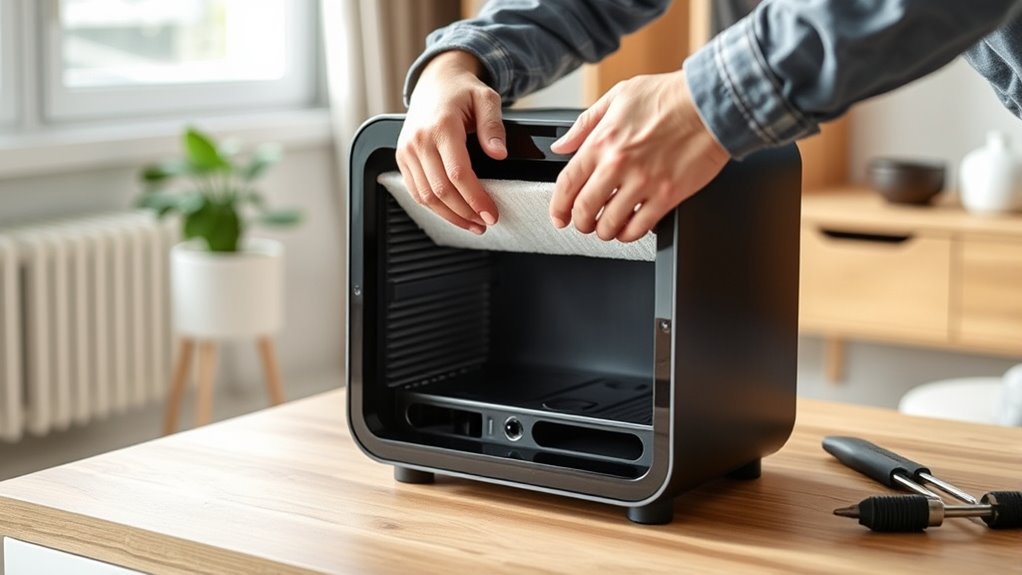
Have you ever noticed that your air purifier becomes noisier over time? Regular cleaning and maintenance can help keep it running quietly. Start by checking the filter and replacing it when it’s dirty or clogged; a clean filter ensures smooth airflow and reduces noise. Also, clean the vents and fan blades to prevent dust buildup that can cause the fan to work harder and produce more sound. Adjusting the fan speed to a lower setting can further minimize noise, especially during periods of lighter use. Consistent maintenance not only keeps your device quieter but also prolongs its lifespan. Make it a habit to inspect and care for your air purifier regularly, and you’ll enjoy cleaner air without the unwanted noise.
Add Sound-Absorbing Materials Around the Purifier
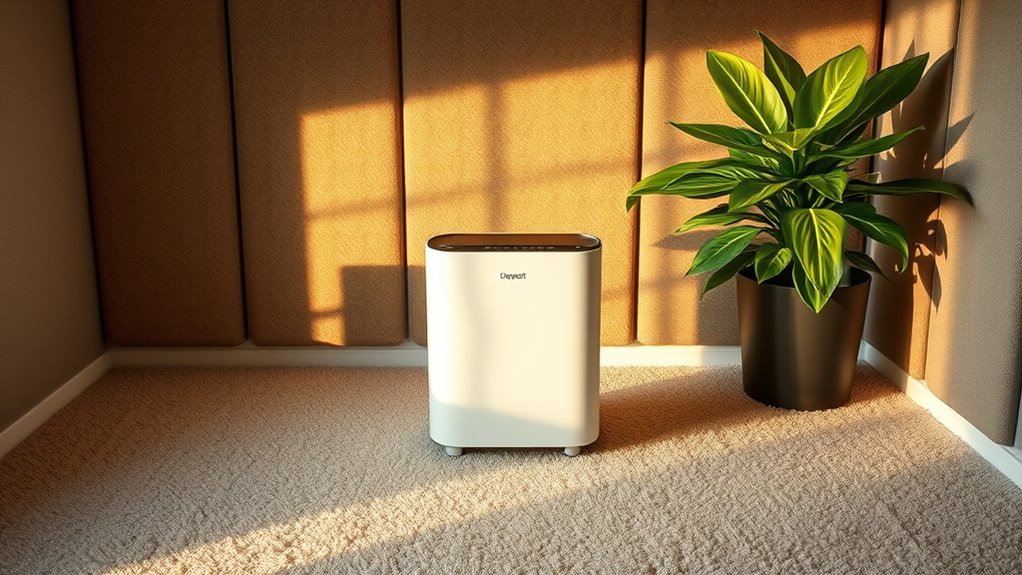
Adding sound-absorbing materials around your air purifier can substantially reduce the noise it produces. You can hang soundproof curtains or install acoustic panels nearby to dampen sound waves. These materials absorb noise rather than reflect it, making the environment quieter. Place acoustic panels on the walls behind or beside the purifier for maximum effect. Soundproof curtains can be hung around the area or in front of the purifier to create a barrier. Combining these strategies creates a more peaceful space. Here’s a quick comparison:
| Material | Best Use | Benefits |
|---|---|---|
| Soundproof curtains | Surrounding the purifier | Easy to install and remove |
| Acoustic panels | Mounted on walls near the device | Effective sound absorption |
| Both combined | For enhanced noise reduction | Quieter environment |
This approach is simple and effective for quieter operation.
Check for and Fix Vibrations and Loose Parts
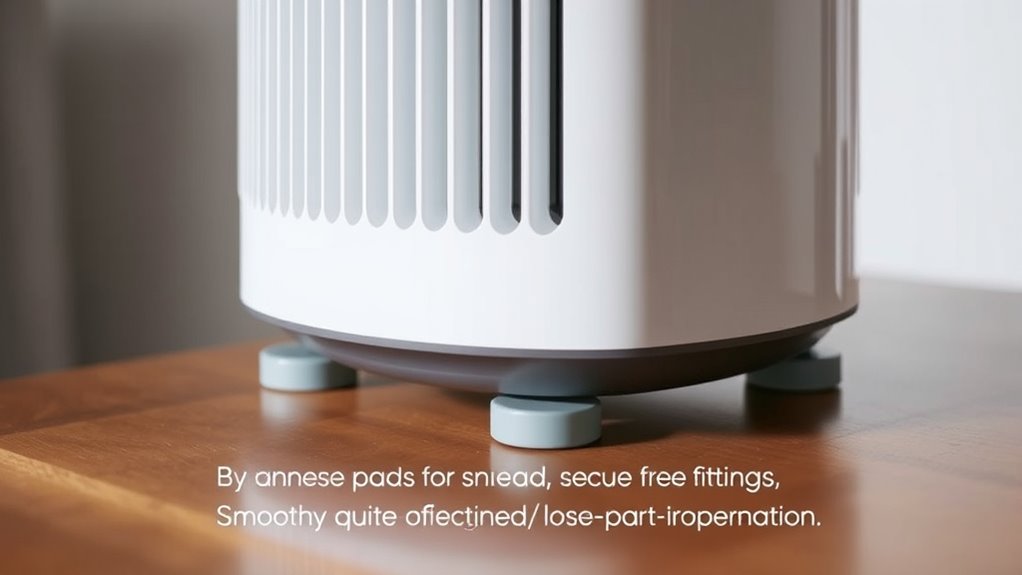
Vibrations and loose parts are common causes of excess noise in air purifiers. To reduce this, start by inspecting your device for any loose screws, panels, or components. Tighten loose screws and secure any rattling parts to prevent unnecessary vibrations. Vibrations mitigation often involves placing your purifier on a level, stable surface, which minimizes movement and noise. If you notice parts that are loose or rattling, perform loose part repair by reattaching or replacing them as needed. Check the fan blades and motor mountings, as loose components here can considerably increase noise levels. Regularly maintaining and tightening these parts can make your air purifier operate more quietly, ensuring smoother, vibration-free performance.
Utilize Noise-Reducing Accessories or Enclosures
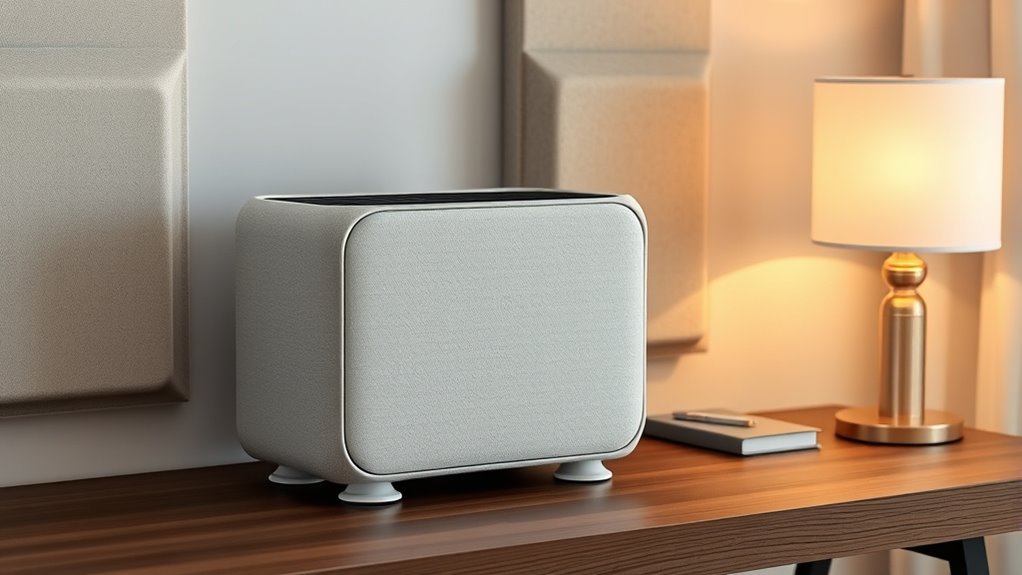
Using noise-reducing accessories or enclosures can considerably lower the sound output of your air purifier. Soundproof enclosures are specially designed cases that contain sound-absorbing materials, muffling the noise without hindering airflow. These enclosures fit around or beneath your device, effectively dampening vibrations and reducing operational noise. Additionally, noise reducing accessories like rubber pads or vibration mounts can absorb vibrations that cause rattle or hum. By integrating these accessories, you prevent noise from transferring through surfaces, making your air purifier much quieter. Be sure to choose enclosures and accessories compatible with your model to maintain ideal performance. This simple upgrade helps create a more peaceful environment without sacrificing air quality.
Run the Purifier During Less Critical Times
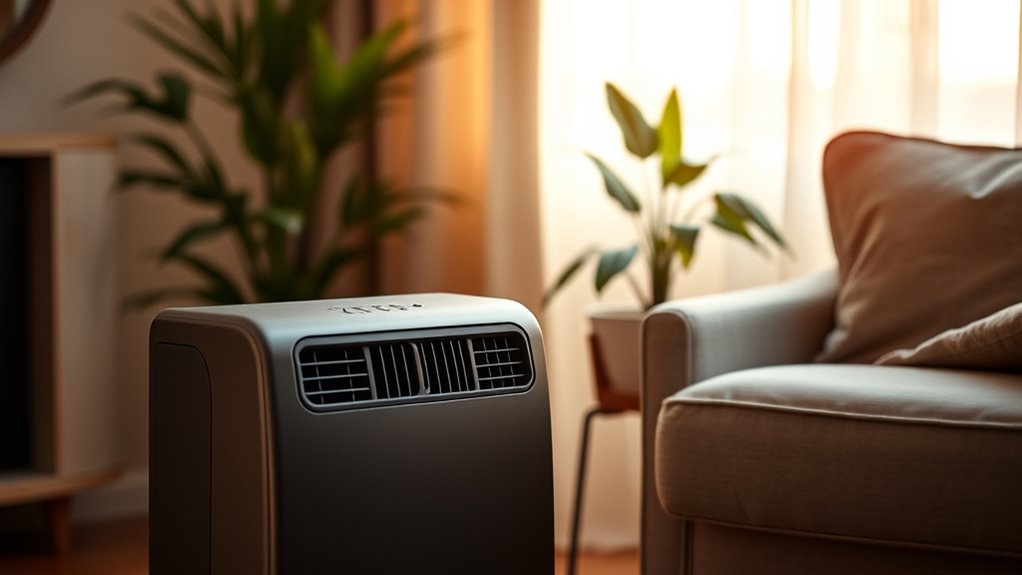
Running your air purifier during times when air quality is less critical can considerably reduce its impact on your daily environment. By adjusting the timing and scheduling operation, you can minimize noise during sensitive moments. Consider these strategies:
- Set your purifier to run only during peak pollution hours or when you’re away
- Use timing adjustments to turn the device off during quiet hours or sleep
- Schedule operation to match your daily routine, avoiding unnecessary noise when you’re most sensitive
These simple changes allow you to maintain good air quality without constant noise. By being strategic with your schedule, you can enjoy cleaner air while keeping noise levels low during less critical times. This approach balances air purification needs with quieter living.
Frequently Asked Questions
What Features Make an Air Purifier Quieter?
To find a quieter air purifier, look for features like adjustable fan speed, which lets you lower noise levels when full power isn’t necessary. Proper filter placement also helps by reducing strain on the fan, making it run more smoothly and quietly. Choose models with sound-dampening materials or noise reduction technology. These features guarantee you enjoy clean air without the disruptive hum, creating a more peaceful environment in your space.
How Does Room Size Affect Noise Levels?
Imagine your room as a vast canyon, where sound waves echo freely. Larger room volume means the air acts like a sponge, absorbing sound and reducing noise levels. In smaller spaces, sound bounces off walls, amplifying the noise from your air purifier. To keep noise down, consider sound absorption strategies or choose a purifier suited for your room’s size, ensuring tranquility replaces the canyon’s echo.
Can Older Models Be Quieter Than Newer Ones?
Older models can sometimes be quieter than newer ones, especially if they have better model durability and come from brands with a strong reputation for quality. You might find that older units run more smoothly and produce less noise because they’ve been well-maintained or built with quieter components. Always compare specific models, considering brand reputation and durability, to guarantee you choose a quieter air purifier that fits your needs.
Is Noise Level Testing Standardized Across Brands?
Think of noise level testing like a universal language, but unfortunately, testing standards aren’t always the same across brands. While some manufacturers follow strict noise measurement protocols, others might not, making comparisons tricky. To get an accurate idea of a purifier’s quietness, look for units that conform to recognized testing standards. This ensures you’re comparing apples to apples, not apples to oranges, when it comes to noise levels.
Are There Specific Brands Known for Quiet Operation?
You’ll find that some brands, like Coway, Blueair, and Dyson, are known for quiet operation. Their brand reputation is built on producing devices with minimal noise, and customer reviews often highlight their quiet performance. When choosing an air purifier, look for those with high ratings and positive feedback for noise levels. This guarantees you get a model designed for quieter, more peaceful use, aligning with your preference for a quieter environment.
Conclusion
Reducing your air purifier’s noise level makes your space more comfortable and enjoyable. Did you know that properly maintaining your device can cut noise by up to 50%? By choosing a quieter model, placing it wisely, and cleaning regularly, you can enjoy fresh air without the disturbance. Implement these tips and experience a quieter, more peaceful environment—breathe easier and sleep better with less noise around.
